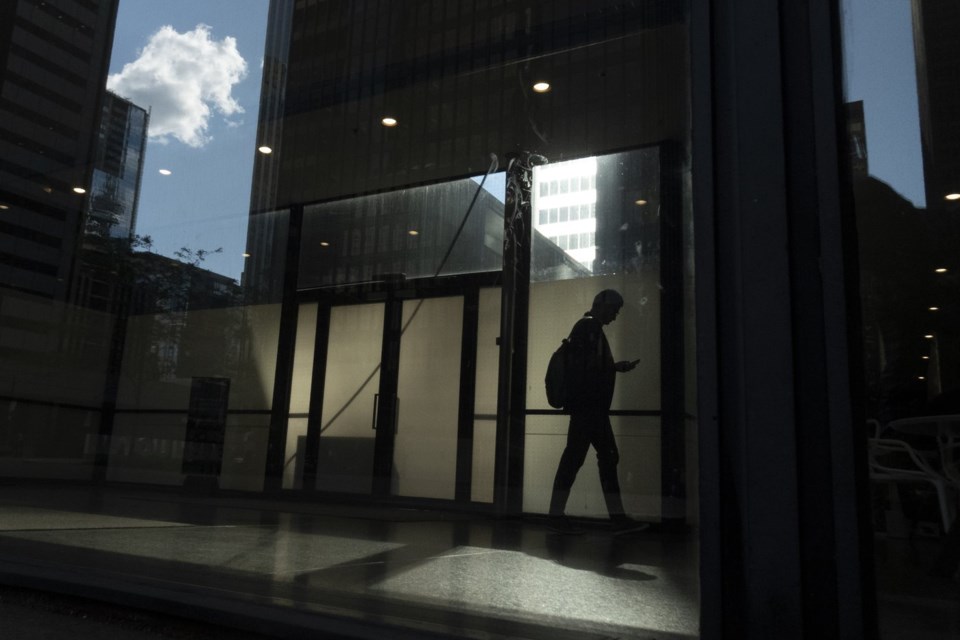OTTAWA — Canadian job seekers and young workers are struggling through the dog days of summer even as the labour market shows limited strain from U.S. tariffs.
Statistics Canada on Friday reported 41,000 job losses last month, while economists had expected a slight gain.
The unemployment rate was unchanged at 6.9 per cent in July as StatCan said the number of job seekers held steady month-to-month.
The economy lost 51,000 full-time positions in July, and the bulk of the losses were in the private sector. The information, culture and recreation sector led the drop in employment, followed by construction.
Doug Porter, chief economist at BMO, said in a note to clients that July's jobs report marked the weakest in three years, according to the bank's report card.
He noted that total hours worked fell 0.2 per cent in July, marking a poor start to the third quarter for Canada's economy.
"This is an unambiguously weak report ... although it comes hard on the heels of an unambiguously strong report," Porter said.
July's drop in jobs partially offsets an unexpected gain of 83,000 positions in June.
Average hourly wages meanwhile rose 3.3 per cent on an annual basis in July, up a tick from June.
Brendon Bernard, senior economist at jobs search site Indeed, said in an interview that the "malaise" he's seen in Canada's labour market in recent years stretched into the summer.
But while Canada's economy remains beset by U.S. President Donald Trump's trade war, Bernard said he didn't see clear signs of tariffs impacting the July job numbers.
StatCan said the layoff rate – the proportion of people employed in June but laid off in July – was virtually unchanged at 1.1 per cent from the same month a year ago despite the economic uncertainty.
The manufacturing industry and the transportation and warehousing sector — two areas Bernard said he'd expect to see tariff impacts — both posted job gains in July.
Regionally, job losses were also concentrated in Alberta and British Columbia, not Quebec or Ontario.
"That's not the markings of all this trade uncertainty dragging on the numbers," Bernard said.
"Instead, we see familiar trends that have cropped up over the past few years: weak youth job numbers, struggles of unemployed people finding new work."
Youth aged 15 to 24 lost 34,000 positions last month while the employment rate for the age group fell to 53.6 per cent – the lowest level since November 1998, outside the COVID-19 pandemic.
Bernard said the youth summer jobs market starts in May and peaks in July, and the latest labour figures show the entire summer has been a slog for young workers.
But it's not just youth struggling to find work.
Of the 1.6 million people who were jobless in July, 23.8 per cent were in long-term unemployment, meaning they’ve been on the job hunt for 27 weeks or more. StatCan said that’s the highest share of long-term unemployment since February 1998, again excluding the pandemic.
Bernard said Canada's job switching rate is also relatively low.
When Canadians are not switching jobs, he said that creates a "traffic jam" of mid- and entry-level positions — the kinds of openings that young workers or the recently unemployed would be after.
And with tepid hiring demand from employers, Bernard said those looking for work are now having to compete harder for a scarce number of positions.
"There's no catalyst right now for a real turnaround that would get conditions for job seekers back in the right direction," he said.
TD Bank senior economist Leslie Preston said in a note that the employment figures are often volatile in the labour force survey, but the unemployment rate is the "key metric to watch."
"The unemployment rate did hold steady, but given it was due to declining labour force participation, is not a very positive sign," she said.
"We expect the stagnation in labour force growth to continue, which will keep the unemployment rate from rising too high, despite weak labour demand."
The Bank of Canada will be gauging the strength of the labour market as it prepares for its next interest rate decision on Sept. 17.
The central bank left its policy rate unchanged at 2.75 per cent in its decision last week.
CIBC senior economist Andrew Grantham said in a note Friday that the "weaker than expected" employment figures support his call for a quarter-point cut at the Bank of Canada's September meeting.
RBC senior economist Claire Fan said in a note that the July jobs report lines up with the bank's expectation that "the bulk of tariff-related damage could already be done."
Fan said she expects the jobless rate could peak soon around seven per cent, and that RBC is maintaining its call for no more rate cuts from the Bank of Canada.
The central bank will have a look at another set of jobs data for August, as well as a pair of inflation reports and a quarterly GDP update before its next interest rate decision.
This report by The Canadian Press was first published Aug. 8, 2025.
Craig Lord, The Canadian Press



